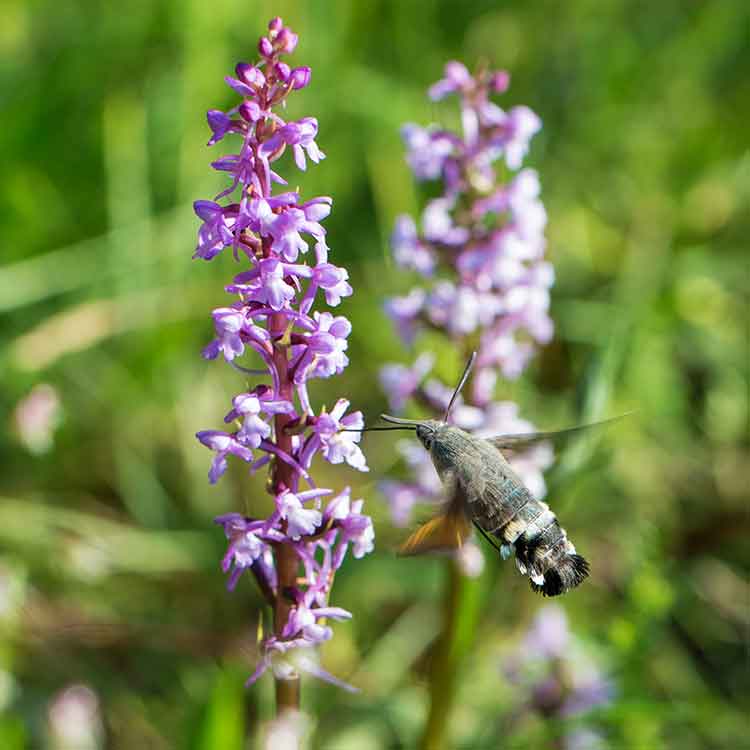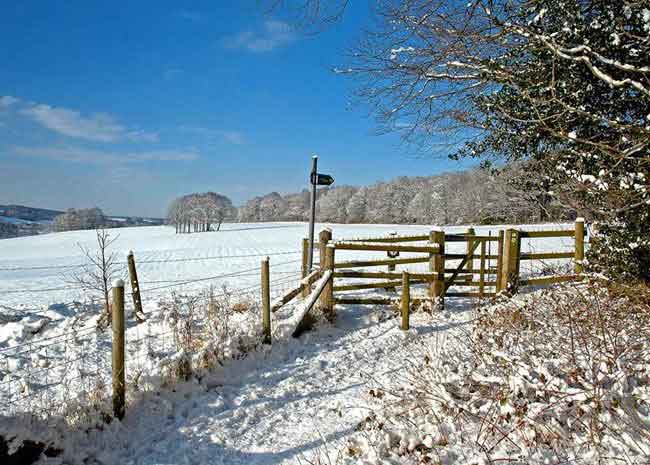Doug Kennedy tells us where they can be found.
The natural beech woods and chalk grassland of the Chiltern Hills support the majority of the 53 species of orchid native to the UK. When compared with the spectacular tropical specimens that have become so popular as house plants, our orchids are understated, but they often have beautiful flowers and fascinating habits.
The more common orchids can cover grasslands in spikes of pink flowers, while others hide in shady forests and can be difficult to recognise as plants, with flowers that never open, or which have a narcotic effect on visiting insects. This article highlights some of the best wildlife reserves in which to see native orchids and describes something about their character and habits. All the reserves are crossed by footpaths, and as most of those covered here are on the western edge of the Chilterns, a visit brings the benefit of great views across the countryside.
Homefield
Managed by the Berks, Bucks and Oxon Wildlife Trust (BBOWT), Homefield is on The Chiltern Way above Danesfield. The single small field is the only place in this region where the rare military orchid flowers each May. Its pinkish-violet flowers are quite large for a British orchid and are clustered on a tall green stem. Several orchids are named after the appearance of their flowers. Military orchid flowers look like a sort of helmet, with two legs and dots that could be buttons. Military orchids are easy to spot, but finding fly orchids, which also grow here, is far trickier. They have a slender stem with small, burgundy-coloured flowers that are deemed to look like a few flies on a stem.
Bernwood Meadows
This BBOWT reserve isn’t within the Chilterns, but is worth including because, each May, green-winged orchids flower in their thousands across the breadth of the two damp fields that make up the site. Their colour varies from deep reddish-purple to white, but their name comes from greenish veins along the sepals. The flowers’ powerful scent attracts bees, and although they pollinate the flowers, there’s no nectar for them. Visitors to these meadows are treated to a mauve profusion of perfumed orchids, interspersed with bright yellow buttercups and birdsfoot-trefoil.
Aston Clinton Ragpits
Another tiny BBOWT reserve, hidden behind a screen of trees just off the B4009 above Aston Clinton. It was once a chalk quarry, but when it fell into disuse it became a haven for wildlife and has been managed by BBOWT for 20 years. It’s an odd place with steep inclines and hollows, but nine species of orchid can be found here, starting in June with the stately spikes of greater butterfly orchids. Thousands of chalk fragrant and common spotted orchids follow, along with many other wildflowers, attracting lots of butterflies throughout the summer. If you look carefully, you’ll also find huge numbers of common twayblades, which are green and easily missed, but which provide abundant nectar for visiting insects.
Pulpit Hill & Grangelands
Whichever route you take, you need good legs to tackle Pulpit Hill just north of Princes Risborough, as its flanks are very steep. This is a National Trust reserve, with an ancient fort at its summit, among the mature beech trees. It’s a great place to hunt for fungi in the autumn, but on its slopes in the summer, under the dark beech canopy, can be found strange orchids that often look like something that didn’t quite make it. There are several species of helleborine orchids, including the green-flowered helleborine, whose flowers never open, being self-pollinating. The bird’s nest orchid is probably the strangest – pale brownish in colour, looking like a withered plant, and sustained by symbiosis with a mycorrhizal fungus that is also a symbiont of beech trees. The strange flowers produce nectar to attract pollinating insects.
The lower slopes of Pulpit Hill are mostly open chalk grassland, part of which forms the Grangelands BBOWT Reserve. When the summer arrives, the green sward becomes speckled with common spotted, fragrant, pyramidal, twayblade and musk orchids. You can also find the occasional bee orchid, which has the largest flowers of all British species, resembling a bumblebee.
Aston Rowant National Nature Reserve
Aston Rowant NNR is unusual in being split in two by the M40, the building of which across this fabulous chalk grassland was very contentious and, some would say, legalised vandalism. The reserve covers two spurs in the Chiltern scarp, Beacon Hill and Bald Hill, and comprises steep chalk grassland where dozens of species of wildflowers compete for space each summer. On the upper slope of Bald Hill, you can find huge numbers of common spotted, fragrant and pyramidal orchids and, if you look very carefully indeed, you may spot some frog orchids. These are small and inconspicuous with reddish to greenish flowers and live for a single season, so are found somewhere different each year. This reserve is also a great location for butterflies, and on a summer afternoon chalkhill and common blues, marbled whites, dark green fritillaries and meadow browns dance in profusion among the carpet of flowers.
There are several other reserves not mentioned here, such as Warburg, Dancersend, Whiteleaf, Watlington Hill and Ivinghoe, where orchids grow, but they can be also found in many locations in the Chilterns: along roadsides, on the borders of fields and woods, and even on wasteland. We’re fortunate indeed to have so many of these intriguing and rare plants, so if you haven’t noticed them before, take the time to visit one of our reserves and look more closely at what is colouring the ground.
Photo by Colin Drake.





